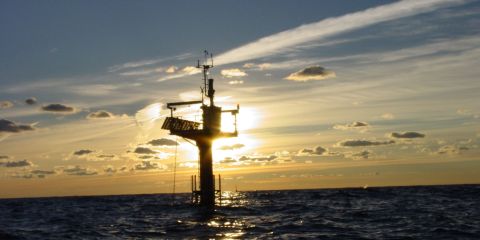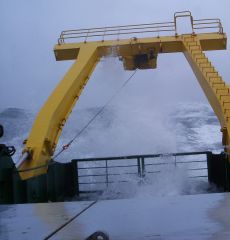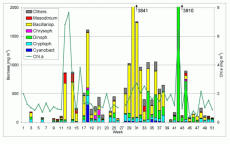

Phytoplankton development at the coastal station "Seebrücke Heiligendamm" in 2005
The results of the weekly sampling at the sea-bridge Heiligendamm (54°08,55' N; 11°50,60' E, 300 m off shore, 3 m water depth), performed by the Baltic Sea Research Institute Warnemünde (IOW) are shown in Fig. 1. The line reflects the chlorophyll a concentration and the columns the phytoplankton wet weight. The phytoplankton biomass was determined by microscopic counting and the chlorophyll a concentration by ethanolic extraction and fluorometric measurement according to the HELCOM manual (http://www.helcom.fi/Monas/CombineManual2/CombineHome.htm).
Quantitative microscopic counting was not possible in week 1,2, 4, 5, 7, 8, 13, 16, 23, 27 and 39 due to high content of resuspended sediments in the samples owing to strong wind.
The chlorophyll a data showed that phytoplankton concentration was generally low up to the 15.3.2005 (week 11). As expected, cryptophyceae (Teleaulax sp., Plagioselmis prolonga, Hemiselmis sp.) were dominant. Besides, the typical autumn dinoflagellate Ceratium tripos, also typical spring species (Chaetoceros curvisetus, Ch. brevis, Mesodinium rubrum) were already present on 17.1.05. These Chaetoceros species could, however, not dominate the spring bloom, that started on 22.3.05 (week 12). The genus Chaetoceros had biomass of 110 mg m-3, Rhizosolenia setigera had 260 mg m-3, Skeletonema costatum 117 mg m-3 and Thalassiosira spp. 92 mg m-3 on 22.3.05 . The spring bloom began relatively late in 2005. Rhizosolenia setigera disappeared completely by the end of the bloom (6.4.2005), whereas Chaetoceros cf. wighamii became dominant with 338 mg m-3. This species was hard to identify as it occurred in single cells. It could also include Ch. holsaticus and the ominous Ch. salsugineus. These species, except for Skeletonema costatum had decreased strongly by 12.4.05 (week 15). Skeletonema costatum was superseded by Rhizosolenia setigera (310 mg m-3) by 26.4.05. On 3.5.05 (week 18) Rhizosolenia setigera reached a peak biomass of 660 mg m-3, and Chaetoceros similis 289 mg m-3. At the end of such a bloom, cryptophyceae (Teleaulax sp., Plagioselmis prolonga, Hemiselmis sp.) are promoted. Also dinoflagellates (e.g. Heterocapsa rotundata, Katodinium glaucum) and chrysophyceae („naked“ form of Dictyocha speculum) developed after the bloom, but much less than in previous years. For example, a naked dinoflagellate (Gymnodinium cf. lohmannii) had high abundances in spring 2002, and Dictyocha speculum in spring 2003 and 2004. The short appearance of Aphanizomenon sp. (305 mg m-3) on 3.5.05 is unusual but sometimes found in the Baltic Proper. Also Ebria tripartita was found in this sample (224 mg m-3), but its identification is not completely sure and such heterotrophic species are not considered in Fig. 1 anyway. By 10.5.05 (week 19), all phytoplankton components decrease drastically. Only cryptophyceae and Rhizosolenia setigera kept some importance, since 19.5.05 also Dictyocha speculum.
The spring situation was terminated at the end of May by a collapse of the phytoplankton biomass. Only Teleaulax sp. and unidentified flagellates (2-5 µm) are worth mentioning on 31.5.05. In June and July, cryptophyceae (Teleaulax sp., Plagioselmis prolonga, Hemiselmis sp.) re-established, while dinoflagellates (Heterocapsa rotundata, later on Ceratium tripos) and especially the typical summer diatom Dactyliosolen fragilissimus appeared and grew quickly. The minimum on 28.6. (week 26) was an artefact because a lot of sediment particles in the counting chamber have hidden the algae. Dactyliosolen fragilissimus reached its biomass maximum with 3560 mg m-3 on 26.7.05. On 16.8.05 (week 33), Mesodinium rubrum and Eutreptiella sp. (here included in „Others“) appeared shortly. By the 23.8.05, the diatom composition changed totally. Cerataulina pelagica, Guinardia flaccida, Proboscia alata and Rhizosolenia pungens emerged instead of Dactyliosolen fragilissimus. The typical dinoflagellate Ceratium tripos (470 mg m-3) became dominant. After another water body was drifting to the sampling station on 30.8.05 (with Dactyliosolen fragilissimus, Nodularia spumigena and Aphanizomenon sp.), the same situation as on 23.8.05 was registered on 6.9.05. The biomass decreased further. As seen already from the chlorophyll data, the low phytoplankton biomass is an artefact due to a high share of sediments in the sample, again.
By the 18.10.05 (week 42), Ceratium fusus (1853 mg m-3) and C. tripos (1841 mg m‑3) formed an extreme bloom. It is interesting that they formed also micro-swarmers. Such a strong growth within one week is not expected. We rather think that another water body from the western Baltic was flown in, which flew out of the investigation area already one week later. On 2.11.05 (week 44) Ceratium was accompanied by Guinardia flaccida, Dictyocha speculum, Teleaulax sp., Dactyliosolen fragilissimus and Mesodinium rubrum. One week later, Ceratium disappeared, but re-appeared on 15. and 23.11.05 (week 46, 47), together with Guinardia flaccida. On 29.11.05, Coscinodiscus granii was dominant, which is a sign for an inflow of water from the Baltic Proper. The phytoplankton biomass stayed low since 9.11.05 (Woche 45).
IOW, 02.02.2006
Dr. Norbert Wasmund,
Susanne Busch,
Ina-Marie Topp,
Regina Hansen.

State of the Baltic Sea
- Annual Reports on the state of the Baltic Sea Environment
- Cruise Reports
- Data from the autonomous measuring stations
- Development of the suboxic and anoxic regions since 1969
- Baltic Thalweg transect since 2014
- Algal blooms at Heiligendamm since 1998
- "Major Baltic Inflow" December 2014
- "Major Baltic Inflow" January 2003
- Baltic saline barotropic inflows 1887 - 2018
- Further Reading

